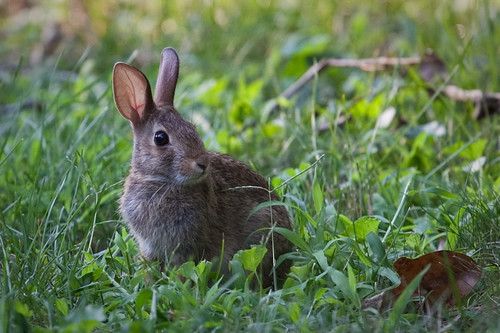
I remember when I first learned that a rabbit ate its food twice.
This curious dietary practice, called coprophagy, is something I'd witnessed as a child raising my own rabbits and guinea pigs in the backyard. Disgusted by the sight of my pets eating their own feces, I recall trying to keep their cages as clean as possible. Had I known better, I would not have been so quick to remove droppings from their cage because I might've put these animals at risk for nutritional deficiency (1-2). Luckily, I wasn't ever very consistent at keeping their cages clean all the time.
Rabbits and guinea pigs, as it turns out, need to eat their own droppings because they provide a valuable source of nutrients like vitamin B12. In the wild, they will normally leave soft droppings at the mouths of their burrows while they go off foraging at dawn or dusk. When they've had their fill of foliage, they return and -- far from being repulsed by having a stack of droppings at the foot of their doorstep -- they eat up these droppings, which are by this time a nutrient-rich fermented dessert.
Being non-ruminant herbivores, rabbits and guinea pigs are adapted to half-digest their food to re-consume it later. Cows, on the other hand, have millions of microorganisms residing within their own multi-compartmental stomachs working to break down their food and producing nutrients. Other mammals, including sheep, apes, and humans have large intestines where microbes live and flourish. Predators don't have a need for such large guts, since they can obtain their nutritional requirements from prey.
Interestingly, humans share a behavior with rabbits and guinea pigs: not that we eat our own feces, but that we allow food to ferment for full nourishment later. Although humans are unique in the sense that we've developed quite a taste for fermented foods. The sheer variety we eat is mesmerizing: yogurt, cheese, wine, beer, vinegar, pickles, kefir, olives, breads, miso and kimchi. All human cultures are dependent on fermented products of some kind as a food source leading to a large variety of human microbiotas across the world (3, 4). Fermented foods are deeply interwoven into the human tale of survival. They are a valuable source of nutrients as well as a valuable method of preservation of foods. There is also much written about how our "inner ecosystems" are important for digestion and our health.
With the development of the Human Microbiome Project and other research projects by scientists related to microbes, I look forward to better understanding how fermented foods may have also helped shape human evolution. As researchers have argued, microbes may be just as important as genes in driving evolution, the human microbiome as important as the human genome. In addition, if we were to take a cue from those scientists who believe that the use of fire and cooking helps explain how we were able to grow bigger brains while shrinking our guts, it's logical to believe that fermented foods may have had their place as well in the shaping of modern humans.
One thing that's plainly clear is that dietary change (or change in nutrient availability) plays a heavy role in natural selection apart from climate and geographical change. Evolutionary biology is rich in examples of animals relying on bacteria to supply important nutrients in their diets. These are classic cases of higher organisms "delegating" responsibility of digestion or nutrient production to lower organisms. What I find intriguing is learning how much the interaction with bacteria may have guided natural selection in shaping morphological and physiological traits as well as behaviors of different animals including ourselves.
- Bellier R, Gidenne T, Vernay M, & Colin M. In vivo study of circadian variations of the cecal fermentation pattern in postweaned and adult rabbits. J Anim Sci 73(1):128-35.
- Hooper DC, Alpers DH, Burger RL, Mehlman CS, Allen RH. J Clin Invest 1973 December; 52(12): 3074–3083. doi: 10.1172/JCI107506
- Scott R, Sullivan WC. Ecology of Fermented Foods. Research in Human Ecology 2008;15(1):25-31.
- Yatsunenko T, Rey FE, Manary MJ, Trehan I, Human gut microbiome viewed across age and geography Nature 486, 222–227 (14 June 2012) doi:10.1038/nature11053






0 comments:
Post a Comment